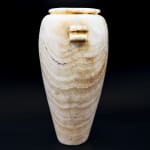Predynastic Lug-Handled Vessel, 3100 BCE - 2700 BCE
Alabaster
22.5 x 11.5 cm
8 7/8 x 4 1/2 in
8 7/8 x 4 1/2 in
CC.63
Further images
-
(View a larger image of thumbnail 1
)

-
(View a larger image of thumbnail 2
)

-
(View a larger image of thumbnail 3
)

-
(View a larger image of thumbnail 4
)

-
(View a larger image of thumbnail 5
)

-
(View a larger image of thumbnail 6
)

-
(View a larger image of thumbnail 7
)

-
(View a larger image of thumbnail 8
)

-
(View a larger image of thumbnail 9
)

-
(View a larger image of thumbnail 10
)

-
(View a larger image of thumbnail 11
)

-
(View a larger image of thumbnail 12
)

-
(View a larger image of thumbnail 13
)

The stone vessel is the emblematic find from Predynastic tomb sites. After all, stone vessels were durable enough to last for eternity; the pottery vases of everyday life were too...
The stone vessel is the emblematic find from Predynastic tomb sites. After all, stone vessels were durable enough to last for eternity; the pottery vases of everyday life were too fragile and disposable to be of service for the deceased in the afterlife. Some may have contained foodstuffs or cosmetics for the nourishment and enjoyment of the ka (spirit) of the deceased, while others were ritually significant objects in their own right. In the afterlife, the deceased needed analogues of the possessions they used in daily life if they were to enjoy the same benefits after death. Even empty, these vessels served their ritual function. The craftsmanship required to produce such stone vases was significant. The outside of the vessel would be roughly carved, before the artisan bored out the middle of the vessel with a bow-drill. Once this laborious task was complete, the vessel was smoothed with different grades of stone.
This tall, slender vase is of an elegant shape that was common throughout Egyptian history. The body and shoulder of the vase are twice the size of the foot; the sensuous curve of the shape is reflected in the irregular banding of the alabaster, the striations of which run diagonally across the vase. There is a wide, everted overturned rim, surrounding a small aperture. Just below the shoulder are two lug handles, broken in antiquity, which would originally have been in the tubular shape commonly associated with vases of the Naqada III period, to which this vase can be dated. The vase still has remnants of its former contents on the inside. This vase is ingeniously designed; though it seems fairly innocuous from the outside, on the inside the vase has been drilled in two stages, leaving a thick rim around the middle of the vase. The result is that the foot, even though it is so much smaller than the shoulder, remains heavier, and therefore the vase remains stable.
The remarkable workmanship of this vase, as well as its stone material, ensured its durability for the afterlife. The beautiful, elegant shape looks as fresh and timeless now as it did five thousand years ago. This vase demonstrates the concern for eternity for which the later Egyptians would become famous.
This tall, slender vase is of an elegant shape that was common throughout Egyptian history. The body and shoulder of the vase are twice the size of the foot; the sensuous curve of the shape is reflected in the irregular banding of the alabaster, the striations of which run diagonally across the vase. There is a wide, everted overturned rim, surrounding a small aperture. Just below the shoulder are two lug handles, broken in antiquity, which would originally have been in the tubular shape commonly associated with vases of the Naqada III period, to which this vase can be dated. The vase still has remnants of its former contents on the inside. This vase is ingeniously designed; though it seems fairly innocuous from the outside, on the inside the vase has been drilled in two stages, leaving a thick rim around the middle of the vase. The result is that the foot, even though it is so much smaller than the shoulder, remains heavier, and therefore the vase remains stable.
The remarkable workmanship of this vase, as well as its stone material, ensured its durability for the afterlife. The beautiful, elegant shape looks as fresh and timeless now as it did five thousand years ago. This vase demonstrates the concern for eternity for which the later Egyptians would become famous.












